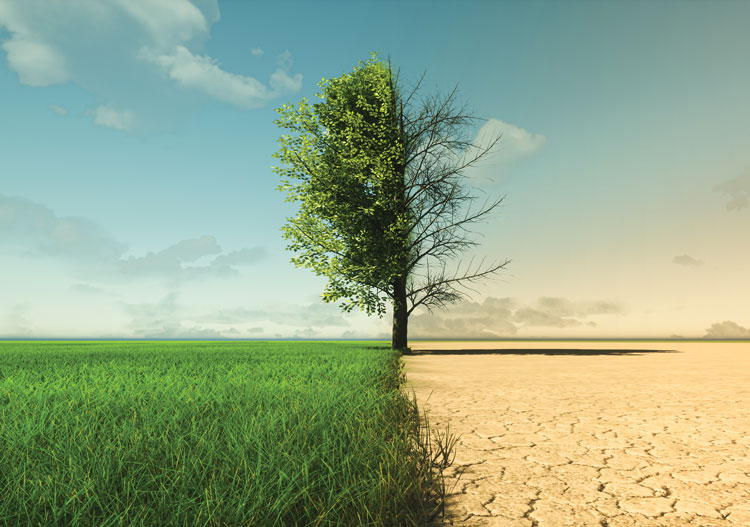The author is an assistant professor at The Ohio State University.

Climate change refers to long-term shifts in temperatures and weather patterns, and it is a consequence of global warming, which is caused by greenhouse gas (GHG) emissions. Greenhouse gases are produced and emitted as a result of human activities.
When the production and emission of GHG expands, they accumulate in the atmosphere. With a thicker layer of GHG in the atmosphere, higher amounts of solar radiation are maintained closer to earth, increasing heat retention. This is global warming.
Global warming does not mean that all places on earth will get warmer. Global warming causes climate to change and initiates a greater number of extreme climatological, hydrological, and meteorological events. Climate change is, therefore, a higher probability or a higher frequency of extreme temperatures (cold or hot), drought or flooding, fire, storms, tsunami, and earthquakes. It all starts with GHG emissions.
The greenhouse gases
There are 86 GHGs known so far. The three most important ones are carbon dioxide (CO2), methane (CH4), and nitrous oxide (N2O). In agriculture, the majority of CO2 (94%) comes from land use change, such as deforestation, fire, or burning; the rest (6%) comes from soils, such as microbial respiration, or organic matter decomposition.
The CO2 that is emitted from soils is not of concern because it is considered part of a “closed cycle” with the uptake of CO2 from plant photosynthesis. The same is true for CO2 from animal respiration.
Most methane (93%) is coming from enteric fermentation, which is a natural process in ruminant digestion; animal waste deposition, decomposition, and pastures; manure storage; and manure application. Nitrous oxide comes primarily from soils (95%), including animal urine deposition in pasture soils (40%), inorganic fertilization, and plant residue decomposition.
It begins with nutrient loss
Generally, nutrient cycling is highly efficient in natural or undisturbed ecosystems, such as forests and native grasslands. In these ecosystems, the synchronization between available nutrient supply and demand by plants is high. The content of nutrients unused (and susceptible to loss) in soil solution is low because nutrient cycling between soil and plants is efficient. Compared to a natural ecosystem, a managed or agricultural ecosystem (or agroecosystem) is more complex, with a larger number of nutrient fluxes in and out of the ecosystem, lesser ability to stock nutrients and, consequently, less nutrient cycling.
The ecosystem components — plant, soil, water, and atmosphere — are intimately connected, and changes in a specific part result in changes in one or more other areas. For example, in grazed pastures, the grazing management implemented establishes rates of plant growth, senescence, and decomposition. These processes, in turn, affect animal related variables, such as grazing losses, excreta distribution, and the amount of nutrients excreted by animals.
Animal variables affect soil characteristics, such as moisture, temperature, pH, aeration, and density. Soil microbial community development and activity establish the intensity of processes associated with production
of CO2, CH4, and N2O in the soil of grasslands. In addition, grazing changes the swards’ structure, affecting herbage quality and, consequently, enteric CH4 emissions.
Another example is the rise in forage primary productivity through the addition of nitrogen fertilization that might increase carbon (C) storage belowground, but simultaneously increase N2O and CH4 emissions from soils.
It ends with management
In any ecosystem, excess nutrients not used by plants or by the microbial community are lost. Nutrients losses in agroecosystems might occur by runoff, erosion, leaching, volatilization, or finally, GHG emissions. Although carbon is technically not considered a nutrient, it is an important element for ecosystems resistance and resilience.
Greenhouse gas emissions, such as CO2, CH4, or N2O, can be seen as nutrient (or element) losses. If we consider that GHG emissions are not different than any nutrient loss, we can apply nutrient management practices to reduce their losses and, therefore, mitigate climate change.
Nutrient management considers the right amount, right source, right placement, and right timing of fertilizers, manure, amendments, and organic by-products to soils as sources of plant nutrients. By considering the “Four R’s,” nutrients taken up by crops are maximized and nutrient losses are minimized. If nutrient loss is minimized, so are the environmental impacts, such as leaching, eutrophication, and water contamination. Conservation management strategies that were designed to reduce nutrient losses to waterways, for instance, work just as well to fight climate change. For example:
- Strip tillage — reduces C loss and increases C sequestration over time.
- Low disturbance manure injection — reduces C loss, increases C sequestration over time, and reduces CH4 and N2O emissions from manure on soil surface.
- Adding grass to alfalfa or grass forage mixes — increases nutrient use and timing, reducing losses via N2O. Also cuts back entric CH4 emissions and soil C loss, increasing sequestration.
- Reduced fertilizer input — reduces losses via N2O.
If climate change is simply viewed as another type of environmental impact, strategies or practices that are considered conservationist and sustainable will work just as well to reduce GHG emissions and mitigate climate change.







